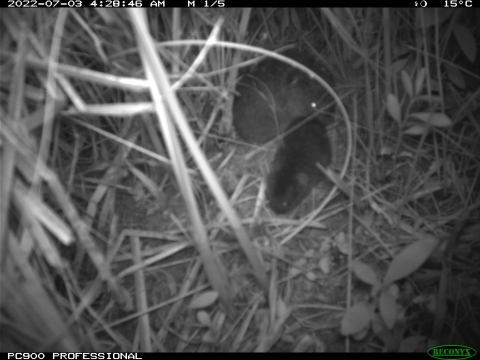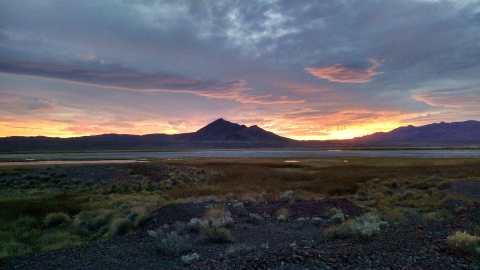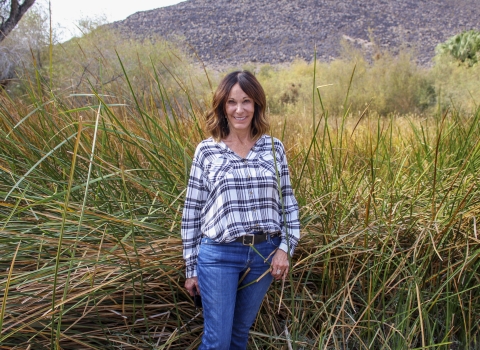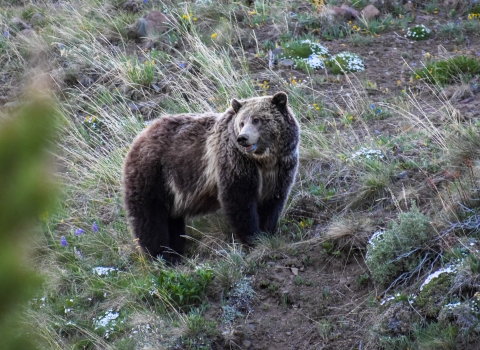Seven years of carefully planned habitat restoration on private land in the Mojave Desert have yielded hope for the persistence of the endangered Amargosa vole. On Aug. 8, a photograph from a wildlife camera placed by researchers from the University of California, Davis revealed the presence of one, possibly two, vole pups born from parents that were reintroduced to restored marsh habitat on private land in Shoshone Village, Inyo County.
The Amargosa vole was first discovered in the marshes of Shoshone in the late 1800s but had disappeared by the early 1900s because of habitat conversion to agriculture and other uses that destroyed the marshes. The only other place in the world where the voles persist in the wild is near the town of Tecopa, about 8 miles south of Shoshone. Restoration of the Shoshone Spring marsh started in 2015 as a joint effort of Shoshone Village, the Amargosa Conservancy, UC Davis and the California Department of Fish and Wildlife (CDFW). The restoration was funded by U.S. Fish and Wildlife Service (USFWS) Section 6 and Partners in Fish and Wildlife grants.
By 2020, the Shoshone Spring marsh habitat appeared comparable to Tecopa marshes that support wild voles, and thus the team was ready to take the next step: returning voles home to Shoshone. The USFWS and landowner entered into a voluntary agreement, and – in coordination with the Bureau of Land Management (BLM) — UC Davis and CDFW have translocated 16 voles from marshes with stable wild populations near Tecopa into the new Shoshone habitat since 2020.
“The goal is to create an independent population in Shoshone to improve resilience of the species,” said Dr. Janet Foley, professor and vole lead at UC Davis. “We were incredibly thrilled to see pups this year on camera – this tells us that the restored marsh has the right conditions to support voles.”
“Amargosa voles live nowhere else on Earth, except these unique Mojave Desert marshes fed by natural springs and the mostly underground Amargosa River,” noted Deana Clifford, CDFW senior wildlife veterinarian and co-lead on the vole reintroduction effort. “By restoring marsh habitat, not only will we help voles, but we will provide critically needed water and habitat that many other species need and will increasingly rely on in the future to survive the predicted impacts of climate change climate change
Climate change includes both global warming driven by human-induced emissions of greenhouse gases and the resulting large-scale shifts in weather patterns. Though there have been previous periods of climatic change, since the mid-20th century humans have had an unprecedented impact on Earth's climate system and caused change on a global scale.
Learn more about climate change . The two go hand-in-hand – to save the vole, we must save and restore the marshes that support not only voles, but many other species.”
“The Amargosa Vole Recovery Implementation Team is an excellent example of how federal and state agencies, academic institutions, non-governmental organizations and private partners can work together to conserve listed species,” said Scott Sobiech, field supervisor for the USFWS Carlsbad and Palm Springs offices. “We can accomplish more for wildlife through collaborative planning.”
For the landowner, Susan Sorrells, this achievement is part of a long-term commitment to land stewardship. “It is so exciting to discover that the first generation of Amargosa voles have been born at Shoshone Spring, their ancestral home!” she said. “As landowners, we are dedicated to incorporating community and nature, and also to protecting endangered species by assessing and stewarding the entire ecosystem. It has been a delight to collaborate with the Amargosa Vole Team as we work together to bring the Amargosa vole back from the brink. If we are successful, the vole will be the second subspecies, joining the Shoshone pupfish, that has been rescued by implementing this approach.”
For now, the vole team will keep watching for more signs of hope in the marsh and will forge ahead with further plans for future habitat restoration.
This project is part of a comprehensive multi-partner program to restore the Mojave’s endangered Amargosa vole. Implemented by the “Vole Team” of CDFW, the USFWS, UC Davis, BLM, Shoshone Village, USGS, and the Amargosa Conservancy. Efforts have involved captive rescue and breeding; research on health, demography, genetics and diet; releases and translocations; habitat restoration; and community engagement.
This news release was originally published on the California Department of Fish and Wildlife website on Sept. 2, 2022.
Media Contacts
- Kat Kerlin, UC Davis News and Media Relations, (530) 750-9195, kekerlin@ucdavis.edu
- Kirsten Macintyre, CDFW Communications, (916) 804-1714, Kirsten.Macintyre@wildlife.ca.gov
- Jessica D’Ambrosio, USFWS Public Affairs, (702) 609-2440, Jessica_Dambrosio@fws.gov






